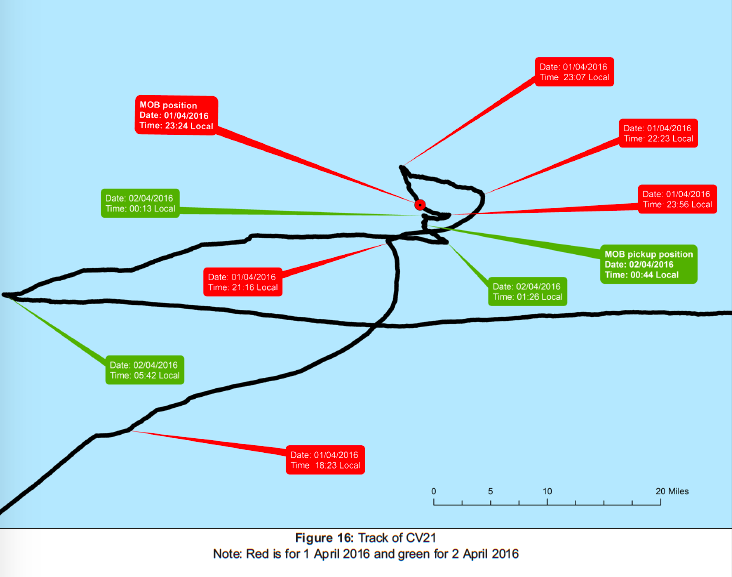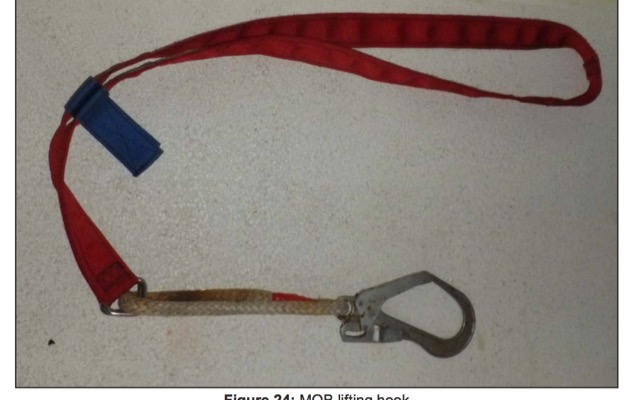Man overboard recovery
At 2324 the shout of “man overboard” was made.
‘Two of the crew down below manned the navigation station, pressing the MOB button on the GPS plotter and starting the engine. A crew member positioned by the mainsheet winch was prevented by the limit of his attached tether from reaching the dan buoy on the aft gantry,’ the report details.
‘The watch leader unclipped his tether and rushed to the automatic identification system (AIS) beacon on the dan buoy. He removed the base pin and twisted the bottom one way and then the other, which caused the beacon light to activate. He then threw the dan buoy, horseshoe life ring and attached buoyant light over the side. The watch leader, who was already dressed in a dry-suit, then went below to don the rescue swimmer harness and helmet.
‘The skipper tried to heave-to but…he was unable to turn the yacht’s bow into the wind. Conscious that he did not want to risk the yacht losing way and sailing backwards, potentially damaging the steering gear, he instructed the crew to get the headsails down.’
A Mayday was broadcast but there was no response. By this time, an AIS target had appeared on the GPS plotter marking the MOB position.

Sarah Young was wearing a manually activated AIS beacon fitted to her lifejacket (no auto-activating AIS beacons were approved at the time). The dan buoy AIS signal was not received by the yacht, but the reasons why are not known as the buoy was never recovered. The report states: ‘It is highly doubtful that Sarah would have been recovered if she had not been wearing a personal AIS beacon.’
Meanwhile, the skipper steered to keep the yacht’s bow up into the wind as much as possible without losing steerage. ‘Three crew on the foredeck hauled the staysail down first. The conditions were such that as the crew hauled the sail down it filled and self-hoisted again. After eventually managing to secure the staysail, they repeated the operation with the yankee 2 headsail.
‘By that time there were four crew on deck manhandling the headsail down, but again the conditions made the process difficult. At one stage, one of the crew was lifted off his feet by the self-hoisting headsail and it was only the limit of his attached tether that prevented him from being lifted higher.
‘At 2356, with the headsails almost down and the mainsheet centred, the skipper was able to steer towards Sarah. The crew at the navigation station used the GPS waypoint ‘Goto’ function, updating the position as the target moved, to provide a course and distance to the AIS target on the navigation display at the wheel. When the skipper first started heading towards the AIS target it was 2 nautical miles (nm) away and appeared to be moving at 2 knots.’
A rescue swimmer fitted in harness and lifejacket was made ready on deck at the port shrouds with a tether to the shrouds to prevent the swimmer swinging out too far.
Lights were spotted in the water, which turned out to be the horseshoe life ring, so the skipper headed for another light and at 0013 on 2 April the yacht approached Sarah Young in the water. It was apparent, says the report, that she was conscious, but ‘her lifejacket sprayhood was not in position.’
Several attempts were made to approach Sarah. On the first attempt she was not close enough to the rescue swimmer. ‘On the next pass, the rescue swimmer made contact with Sarah, but she slipped free.
‘Shortly afterwards, Sarah was seen briefly grabbing the port guardrail before she let go and drifted out of sight astern.’
The rescue swimmer was winched out of the water and released ‘an estimated 50-75 per cent of inflation gas from his lifejacket to make it easier for him to work when in the water.’
On the next approach one of the crew hanging over the side managed to grab hold of Sarah, and the rescue swimmer was given enough slack in the halyard to go and grab her. But it appeared Sarah had lost consciousness.
‘Believing he [the rescue swimmer] had secured the halyard to her, he instructed the crew to winch up on the halyard. However, the lifting hook had not been connected securely and Sarah dropped back into the water. The swimmer was then towed along underwater for a short period as the yacht picked up speed until he was winched up clear of the water once again.

‘On the final approach, Sarah was level with the shrouds and the rescue swimmer was able to swim out and place the loop of Sarah’s long tether, which was still attached to her harness at both ends, over his head. He then successfully attached the lifting hook to her. At 0044, Sarah, who was unresponsive at this time, was lifted on board and lowered onto the deck.’



